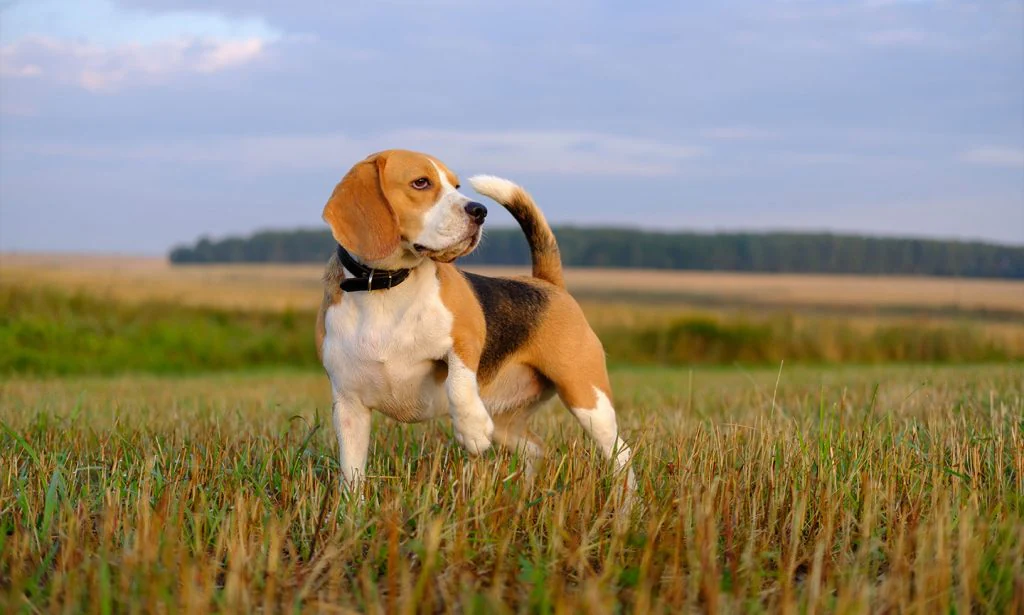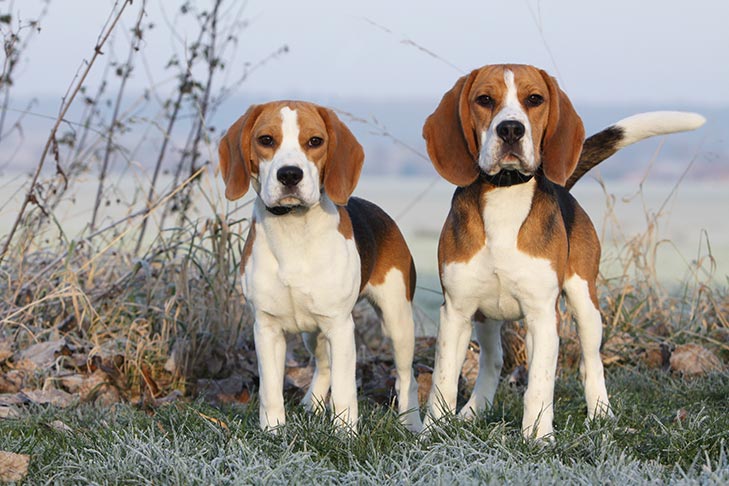Beagles are medium-sized dog breeds bred for hunting. According to the FCI classification, the breed belongs to the group of hounds of small size. A dog of this breed is well suited for keeping in an apartment, very sociable and friendly. The Beagle loves to run and is always energetic, so it can be an excellent companion for outdoor walks with the owner.
There are different versions of the origin of the breed. One of them says that the Romans were involved in the creation of this type of hounds, who brought them to their northern English province. The English version claims that such dogs were successfully bred by the Britons long before becoming vassals of the Roman Empire. According to this version, Beagles were faithful companions of the Knights of the Round Table. At the same time, all versions agree that the modern look of the beagle was determined precisely in England.

Compact dogs were suitable for hunting small game in wooded areas, which often escaped from pursuit in dense thickets of bush. It was problematic for larger hounds to get through such thickets, because they “got stuck”. Small specialized breeds of dogs of strong build with “running” paws of normal length and powerful jaws for holding prey did an excellent job with this task.
Two breed lines, the purpose of which was to hunt small animals, were determined by the middle of the 18th century in England. These included the southern hound breed and the northern beagle. In the middle of the 19th century, Parson Honeywood created the base of the modern breed, which he introduced in Exex, a county in the southeast of England. Descendants of this breed are found in modern nurseries to this day.
An advertisement for this hunting dog was made by the famous English naturalist Charles Darwin, who in 1831 set off on a round-the-world voyage on a small scientific vessel, the Beagle. The result of the scientist’s five-year expedition was his book “The Origin of Species by Means of Natural Selection”. The name of the breed on that journey was immortalized twice. The second time – on a geographical map in the form of an open Beagle Channel connecting the Atlantic and Pacific oceans in an archipelago at the southern tip of South America.
At the end of the 19th century, Americans brought beagles from northern England. The first field trials were conducted at the National Beagle Club.
Breed features
The Beagle belongs to the group of small hounds. Country of origin, according to the international standard – Great Britain.
On average, beagles live 12-15 years.
Beagle’s appearance
The main characteristics of appearance: a strong and compact physique, a strong dog, but not rough.
Permissible height for males: 36-41 cm.
Permissible bitch height: 33-38 cm.
Weight: 9-11 kg, males are slightly heavier.
Beagle coat: dense and short, no undercoat.
The color of the beagle is varied. The most common tricolor combination of red, black and white. There are also such options in the color of the beagle:
- blue with red and white,
- variegated with lemon color,
- variegated with white
- red with white
- completely white.
In this case, the tip of the beagle’s tail should remain white. In all listed colors, small blotches of a different color may occur. The exception is the white color, in which such a spot is unacceptable.
Structural features of the beagle
The body of the beagle is with a straight and even topline, a strong chest, which is lowered below the elbows. The neck allows you to follow the trail due to the length sufficient for this, the dewlap is small.
Head with slightly convex, moderately broad skull. More elegant in females, more powerful in males. There are no folds, the length is proportional. The muzzle is not sharp, the nose with a black lobe and wide nostrils. Dark brown eyes set wide apart, not protruding. Long ears with rounded ends. If the ears are pulled forward, they will almost reach the nose.
Forelegs with strong elbows, short pasterns. Fingers with dense pads are collected compactly, claws are short. Hind feet with muscular thighs, strong hocks. Fingers and claws are similar in structure to the structure of the fingers and claws of the front paws.
The beagle’s tail is set high, not curled. Densely covered with hair, moderate length, thick.
Character
The Beagle is a universal breed not only for hunting, but also for service dog breeding. The place of his employment is often the customs structures, where the ability to find weapons, dangerous chemicals and drugs with the help of a keen sense of smell is highly valued.

By nature, the beagle is non-aggressive due to its hunting origin (the prey should not be caught up and torn apart, but caught as carefully as possible). As a guard, the beagle is not suitable, because it is friendly not only to members of its family, but also to strangers. Of the watchdog qualities, the beagle has only a ringing bark – when necessary, it will raise the alarm.
Beagles are distinguished by curiosity and initiative. This is due to their hunting specialization, where the ability to work at a considerable distance from the owner and make decisions independently is always in demand. There are cases of using these dogs as therapists, as well as guide dogs. He loves sports very much and enjoys participating in active disciplines such as canicross, bikejoring, agility, frisbee, pulling or pitch and go.

